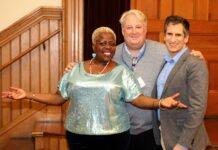By Jean Tarbett Hardiman
HUNTINGTON, W.Va. —
For some patients who have had knee replacement surgery and undergone the subsequent physical therapy, getting the second knee replaced is not an idea they relish. But with a new technology available, the prospect may not be as intimidating.
Dr. Vivek Neginhal of Scott Orthopedic Center, who also serves as director of St. Mary’s Regional Joint Replacement Center, has begun offering this year a new knee replacement option. It involves the patient getting an exact custom implant created through advanced digital imaging technology to create a complete “map” of the knee, and then 3D printing technology used to develop a precise wax mold that helps form the metal component of the total knee.
It’s intended to create an exact fit, so that the surgeon does not have to cut away or alter any tissue to place the implant, which has been done with traditional “off the shelf” implants to get them to fit. Less alteration of the person’s regular tissue means quicker recovery and less post-surgery pain.
Just like every face is different, every knee is different, Neginhal said. It’s accurate to less than a millimeter, and getting that exact fit means the joint won’t be sent reeling, so to speak, trying to adapt to a foreign shape, he said.
“I believe ConforMIS can present a number of significant advantages to patients, providers and payers without increasing hospital costs and while reducing the need for costly inpatient rehabilitation care,” said Neginhal, who is part of a gradually growing trend across the country among orthopedists.
In Huntington, the custom knees are also offered by Dr. Felix Cheung, one of the partners practicing in Cabell Huntington Hospital’s and Marshall’s Department of Orthopaedics.
“That’s a great knee. I’ve been doing it six months now. It’s worked well,” said Cheung, chief of orthopedic oncology, vice chairman of operations for Marshall Orthopaedics and Cabell, and an associate professor at Marshall. “It’s attractive in the sense that early data has shown people have faster recovery and their knee feels more normal. … They do seem to recover faster and they seem to be happier than the people who have had traditional knees I’ve done, but not everyone is a good candidate. The idea is to give you back the knee God gave you. If you have so much arthritis that the knee is already misshapen, we don’t want to give you a misshapen knee.
“I’m happy this technology is available even in rural West Virginia. That’s the exciting part. You don’t have to go out of town with this technology here,” Cheung said.
“These techniques are phenomenal and keep getting better and better,” said Dr. Ali Oliashirazi, who chairs the orthopedics department at Cabell and Marshall. He emphasized that despite the technique, he thinks the best predictors of success in the outcomes are the physician and the institution where surgery is performed.
The notion that custom-fit implants produce faster recoveries has been spot on in the case of 60-year-old Debbie Hicks of St. Albans, who has had two knees replaced by Neginhal, the left replaced through the traditional method in 2012 and the right knee replaced this year with a new designer implant. With the first knee, she intended to go back to work after two weeks, but it took three to feel up to it, she said. With the second knee, replaced in May, she was back to work two weeks later, no problems.
“After two weeks, I would go to therapy and then go on to work. … It was a whole lot different,” she said. Two months later, she’s back to her usual activities, including walking and working in the yard. And that’s especially good news considering it’s still very early in the recovery process, Neginhal said. Usually, it takes six months for any knee replacement to fully recover.
Neginhal now has done about 15 of the surgeries.
Larry Workman of Louisa, Kentucky, started noticing trouble with his knees from osteoarthritis a few years before the surgery. He started having trouble doing the things he loved — gardening and working in his vineyard.
“I love to hunt. I went out to Kansas to go hunting and (was in terrible pain). I thought, ‘I’m going to have to do something,’ ” the 70-year-old said.
He started with cortisone injections, but those weren’t having the desired results. In May, he became one of Neginhal’s pioneers in getting a customized total knee implant from a 3D model.
3D printing is an increasingly used type of manufacturing in which components are built not by cutting away material to create a certain shape, but adding successive layers of a substance until the layers create the shape. The exact design for the component, in this case a knee implant, is entered into the computerized 3D printing machine before it’s produced.
Creating an exact match for each patient had been cost prohibitive before 3D printing, Neginhal said. While it does have a slightly higher sticker price, that likely won’t affect patients with insurance and Medicare, and it can save money in post-surgery therapies, Neginhal said.
Workman had surgery early May and was up and walking at the hospital the day of the surgery. Ten days after surgery, he was riding a stationary bike as part of physical therapy and he was able to fully rotate the pedals. Three weeks after surgery, Workman was walking around without any assistance and working in his vineyard and garden picking strawberries.
He said his arthritis pain is gone, and he is glad to be able to ride his ATV, tractor and lawnmower again.
“I’ve already reached mobility levels a normal knee would reach,” he said, and he expects it to get even better as the six-month recovering period continues and swelling and stiffness disappear.
According to the American Academy of Orthopedic Surgeons, more than 600,000 people have knee replacement surgery each year, and the traditional surgery with an “off-the-shelf” implant is still a good option, said Neginhal, who still performs both types of surgery. Even “off the shelf” components come in different sizes for both men and women and are quite close to the way a person’s anatomy should be.
But for those who fit the criteria, the new method could turn out even better, he said.
“Whenever a new technology comes out, I’m interested, but they don’t always pan out,” he said. “With some, you get the feeling that this would really work.” Physical therapist Christin Knell of Teays Valley Physical Therapy Center has treated a lot of patients post-knee surgery, and said there’s a clear difference with the new type of implant.
Post-surgery therapy can be an extremely traumatic experience for some, Neginhal said. Tears, screaming — not unheard of during these sessions. Patients with the new designer implants get their range of motion back more quickly, with less pain and needing less assistance, Knell said.
In less time, “They’re getting back to work and the things they enjoy in life,” she said. — AP/The Herald-Dispatch












